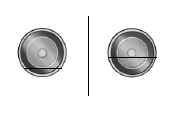Economical driving
Fuel economy is affected by several things, such as how you drive, the conditions you drive under and how you maintain your vehicle.
There are some things to keep in mind that may improve your fuel economy:
• Accelerate and slow down in a smooth, moderate fashion.
• Drive at steady speeds without stopping.
• Anticipate stops; slowing down may eliminate the need to stop.
• Combine errands and minimize stop-and-go driving.
• Close the windows for high-speed driving.<.
• Drive at reasonable speeds (traveling at 55 mph [88 km/h] uses 15% less fuel
than traveling at 65 mph [105 km/h]).
• Keep the tires properly inflated and use only the recommended size.
• Use the recommended engine oil.
• Perform all regularly scheduled maintenance.
There are also some things you may not want to do because they may reduce your fuel economy:
• Sudden or hard accelerations.
• Rev the engine before turning it off.
• Idle for periods longer than one minute.
• Warm up your vehicle on cold mornings.
• Use the air conditioner or front defroster.
• Use the speed control in hilly terrain.
• Rest your foot on the brake pedal while driving.
• Drive a heavily loaded vehicle or tow a trailer.
• Carry unnecessary weight (approximately 1 mpg [0.4 km/L] is lost for every 400
pounds [180 kilograms] of weight carried).
• Add particular accessories to your vehicle (e.g.; bug deflectors, rollbars or
light bars, running boards, ski racks).
• Drive with the wheels out of alignment.
DRIVING THROUGH WATER

If driving through deep or standing water is unavoidable, proceed very slowly. Never drive through water that is higher than the bottom of the wheel rims (for cars) or the bottom of the hubs (for trucks).
When driving through water, traction or brake capability may be limited.
Also, water may enter your engine’s air intake and severely damage your engine or your vehicle may stall.
Note: Driving through deep water where the transmission vent tube is submerged may allow water into the transmission and cause internal transmission damage.
Note: Once through the water, always dry the brakes by moving your vehicle slowly while applying light pressure on the brake pedal. Wet brakes do not stop the vehicle as quickly as dry brakes.
See also:
Changing a bulb
Lamp Assembly Condensation
Exterior lamps are vented to accommodate normal changes in pressure.
Condensation can be a natural by-product of this design. When moist air enters
the lamp assembly thr ...
Power windows
WARNING:
Do not leave children unattended in the vehicle and do not let children play with
the power windows. They may seriously injure themselves.
WARNING:
When closing the power windows, yo ...
Trip computer
Resetting the Trip Computer
Press and hold OK on the current screen to reset the respective trip, distance,
time and fuel information.
Trip Odometer
Registers the mileage of individual journeys.
...
